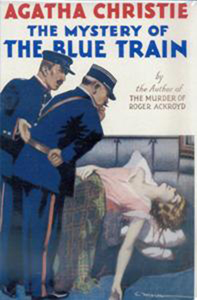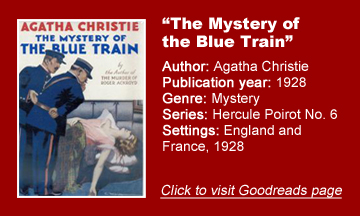After the misfire of “The Big Four,” Agatha Christie gets her groove back one year later with “The Mystery of the Blue Train” (1928). It likewise breaks from formula, but more effectively. It’s a little slow to start, but once it gets going, the mystery of who killed Mrs. Kettering on the titular train through France is ever-present.
But what sets this book apart is Christie’s almost equal focus on romances.
Small-village girl
A small-village Englishwoman who comes upon wealth and now seeks to travel the continent in her 30s, Katherine Grey is the most memorable of the large supporting cast, as she is Poirot’s one-off assistant. Known for her striking gray eyes, she encounters one of the suspects – Mr. Derek Kettering – three or four times in random passing.
As she uses her new wealth to dress fashionably, Katherine draws romantic interest from Derek and Knighton, the secretary of Mrs. Kettering’s father, Van Aldin.
Christie does a nice job of thickening the plot by having characters withhold information from others for small reasons, thus leading to fascinatingly odd moments. For example, Katherine sees Derek entering his wife’s compartment, but she doesn’t tell this to the police because she is intrigued by Derek.
But later, Derek claims to have not entered the compartment; so now the withheld information becomes more ominous. An observer her whole life, Katherine is suddenly an active participant. The author doesn’t carry these moments throughout the whole novel, perhaps because it’s hard to keep so many lies straight, but it’s fun while it lasts.
Unusual wrinkle
There’s a period about mid-book where the evidence points to two characters – but they most likely could not have both done it. A simpler novel would have the evidence point to one suspect favored by the police (and therefore we’d know he definitely didn’t do it).
As is standard, we later get more suspects, but “Blue Train” shows that even when Christie follows formula, she adds an unusual wrinkle.
Although the title draws comparisons to Christie’s later masterpiece “Murder on the Orient Express,” “Blue Train” doesn’t take place entirely on a train. Rather, Poirot pieces together the murder by talking to various suspects and witnesses in Nice and Monte Carlo on the coast of the blue Mediterranean.
There’s not as much of a sense of place as I’d like – although perhaps adaptations emphasize the beautiful scenery – but there is definitely a sense of people’s place in the world: Katherine has come upon money, Derek inherits $2 million upon his wife’s death, Rosalie Tamplin renews her acquaintance with cousin Katherine upon learning of her new wealth, Derek’s mistress Mirelle will only stay with him if he’s rich, and so forth.
(The dancer Mirelle is a femme fatale if there ever was one, but I admit I found the extreme French stereotyping amusing in short bursts.)
If cold hard cash is not the motive, then jewels are; as is often the case in Christie yarns, world-famous jewels – carelessly transported by the robbery victim – come into play. So do false jewels, made of “paste.” More than one character is heavily involved in the market of questionably acquired jewels.

Poirot the people person
Poirot is back in good form here, doing his usual boasting – but it’s more fun to see newcomers react to his preening than to merely have Hastings (absent here) roll his eyes, as is the case in “The Big Four.” Here, Poirot doesn’t merely work the case, he also has a good eye for relationships; he takes a personal interest in Katherine ending up with the right man and leading a good life.
While it’s not exactly filled with lounging by the water, “Blue Train” is fairly laid-back, as Poirot notes that he believes in combining business with pleasure whenever possible. To client Van Aldin’s initial annoyance, Poirot acquires information by talking to people (not too loudly, I hope) in the stands at a tennis match.
We also get several delightful lunches, wherein Poirot’s manners and stories impress his colleagues, especially the women. Young Lenox Tamplin is briefly smitten with the detective, something that might’ve been neat to see expanded upon.
“The Mystery of the Blue Train” is not as good as it could’ve been, as Christie falls back on clichés such as jewel thievery after tiptoeing into a fascinating web wherein many characters know various things about other characters (without the other character knowing).
She could’ve peppered more clues into the first half of the book so we’d have a fairer chance of guessing the solution. She’s not totally into the thematic possibilities, but the personalities sparkle, the solution is clever, and she’s back on the right track after the derailment that was Poirot’s previous adventure.
Every week, Sleuthing Sunday reviews an Agatha Christie book or adaptation. Click here to visit our Agatha Christie Zone.


